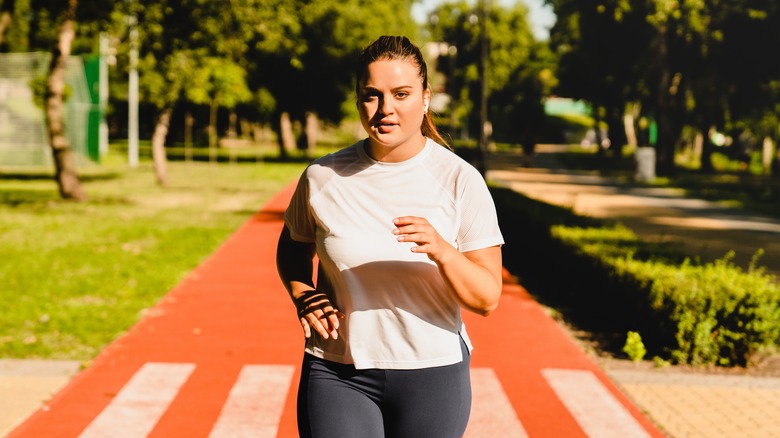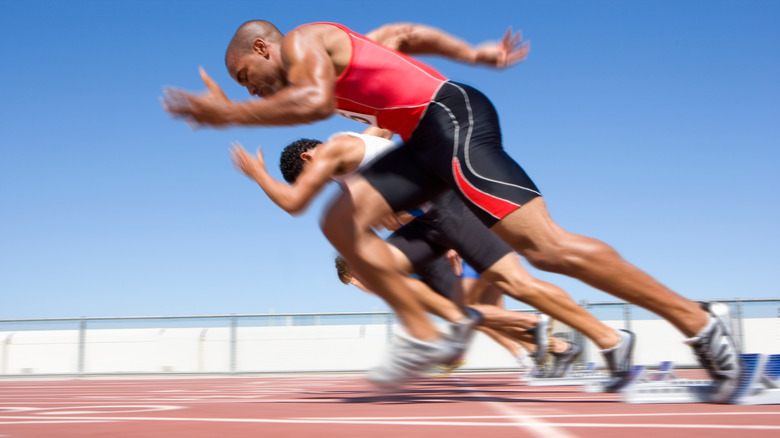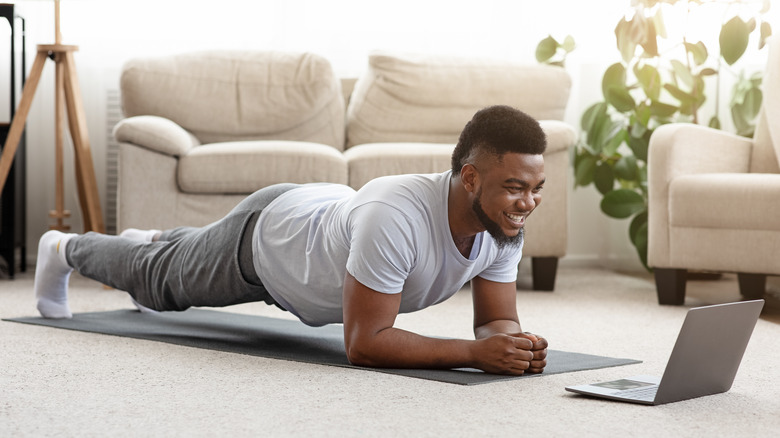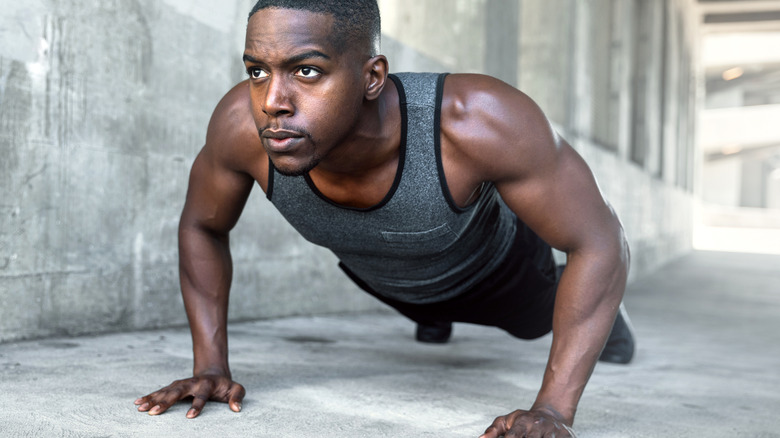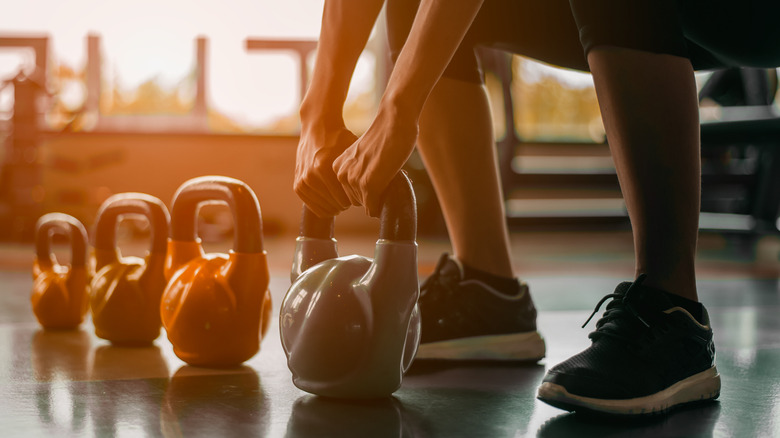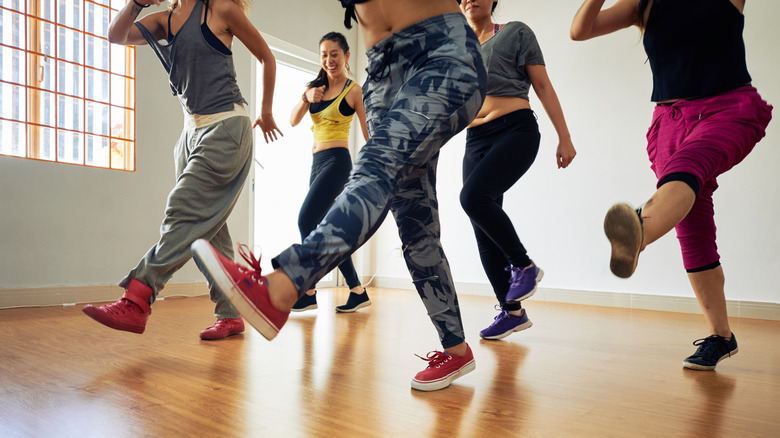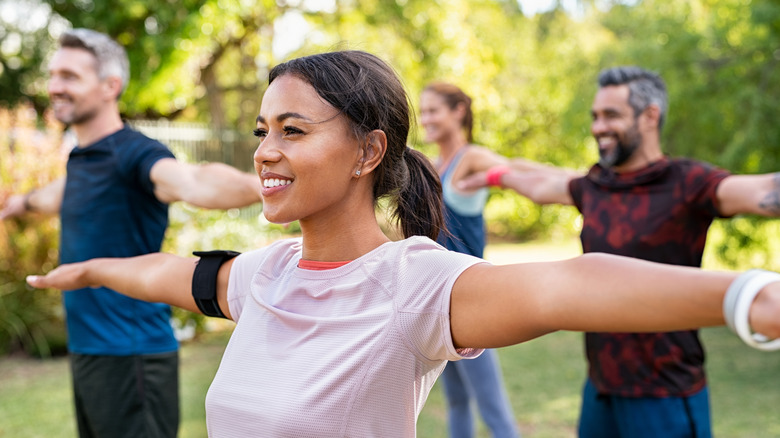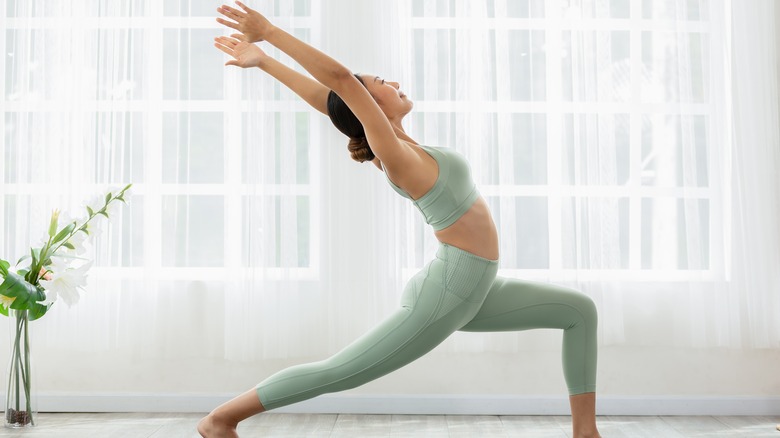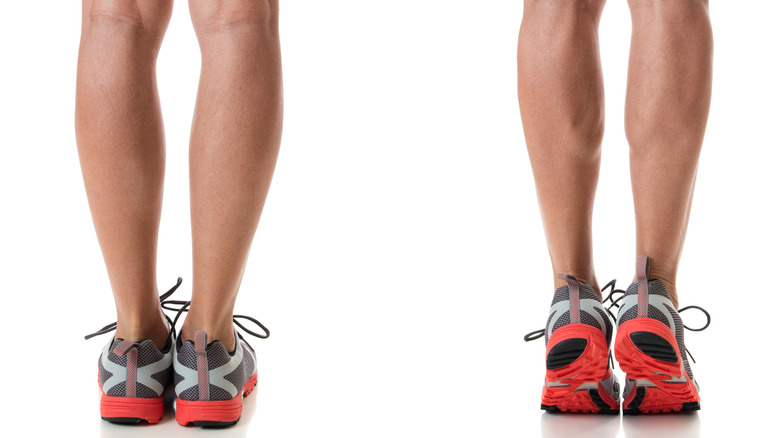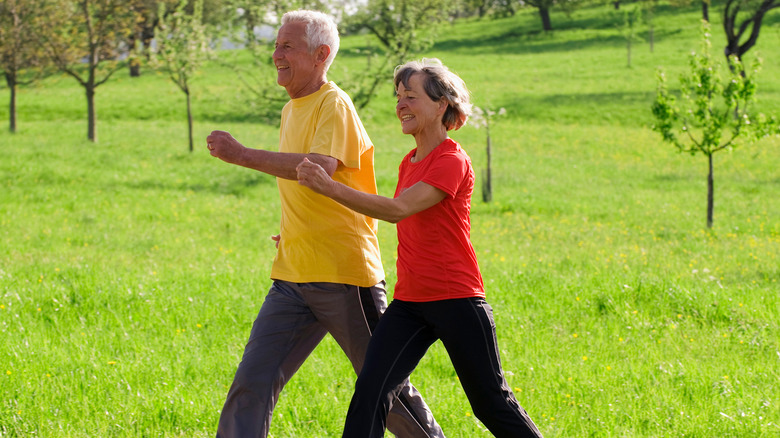The Best Exercises For Distance Runners
So, maybe you've always wanted to be a runner. Specifically, you want to be a distance runner. You're not necessarily interested in the short sprints you see people do around the track — instead, you want to go out and cover cross-country-style long distances. That's a great goal because running does wonders for your health, according to Harvard Health Publishing, which refers to marathoners as the "thoroughbreds" of the running community.
But if you want to get the most out of your running routine, it's best to consider your entire body. You want to be strong, balanced, and flexible if you're going to be a successful runner. You also need to have great endurance. All these needs point to a wide variety of exercises that runners should be putting themselves through if they're going to stay ahead of the pack (either literally or metaphorically). Here are the best exercises that distance runners should be incorporating into their routine.
What is considered distance running?
There's really no hard-set definition of distance running. One person's idea of distance running is going to differ from another person's. And while "distance running" is a colloquially accepted term, Ready Set Marathon explains that this phrase implies specifically long-distance running.
Unlike short-distance running, when runners will try to sprint a few hundred meters as fast as they can, long-distance running entails endurance. It's about covering several kilometers or miles at one time. A 5K (3.1 miles) could be considered a long-distance race. From there, runners could challenge themselves in a half-marathon (13.1 miles), a marathon (26.2 miles), or even an ultramarathon (any distance longer than a traditional marathon, often a 50K, 100K, 50-miler, or 100-miler).
If you're training to participate in a distance race, you'll need to develop several important skills, according to Livestrong. Distance runners need to develop endurance so they can keep going for prolonged periods of time, as well as pacing, so they don't exhaust themselves by going too fast from the very start.
The best way to build endurance is...running (duh)
As the term implies, an endurance runner has to have, well, endurance. That means maintaining stamina, both physical and mental, for an extended period of time. And the best way to do this is with a consistent running routine (via All About Marathon Training). Even a trained runner runs the risk of doing what's known as "hitting the wall" during a long-distance race if they aren't used to running that kind of distance. "Hitting the wall" refers to running out of the glycogen your body uses for energy and not being able to power your leg muscles.
A long run has several important benefits, primarily in the way it improves your body's ability to take in oxygen and transport it to the cells all over your body. Somebody training for a marathon (26.2 miles) will want to work their way up to a training run of about 22-23 miles before race day; similarly, somebody who is training for a half-marathon (13.1 miles) will work their way up to running 10-11 miles before race day.
In the case of a long run, because you're focused on distance, you are able to take it easy on speed. Anywhere from 45 seconds to 3 minutes per mile slower than your goal pace is acceptable. That's not to say, however, that speed workouts don't have their place. Which leads to the next exercise...
Try some high-intensity runs as well
While going long and slow builds endurance, it's still beneficial for runners to learn how to go intensely. Brooks Running explains that activities like speed workouts and hill workouts will increase your running strength, making your cardiovascular system more powerful. And with a stronger, more powerful cardiovascular system, you'll have a better ability to undertake those long, steady runs. These types of workouts are called high-intensity interval training (or HIIT for short) because you push yourself as hard as you can for a short interval, then either rest or do something easy for a few minutes before undertaking another high-intensity interval.
If you want to get scientific about it, you'll have to measure your heart rate. First, determine your maximum heart rate by subtracting your age from 220 and multiplying that number by 0.85. You now know your maximum number of heartbeats per minute. And any short burst of exercise that takes you to 85% of those heartbeats per minute will constitute as "high intensity."
You can still get the benefits of high-intensity exercise without tracking your heart rate. Just sprint as fast as you can for 30 seconds, rest, and repeat. It's also worth noting that some studies indicate high-intensity running isn't as important as some might think, as Active points out. For optimum preparation come race day, runners should focus on high-intensity running only 20% of the time, instead of 50% the way many runners do.
Swimming or cycling are low-impact endurance builders
If you're aiming to improve your endurance, you don't necessarily have to run — other cardiovascular workouts can be just as beneficial.
Maybe you've been sidelined from running by an overuse injury, or maybe you're just looking to find workouts that don't put as much stress on your joints as going for a run every single day would. Low-impact workouts are a great way to mix it up, per the advice of Runners Roost Fort Collins, CO. Two great options are cycling or swimming, both of which fall under the category of low-impact exercise that will still improve your cardiovascular endurance.
But if you're already planning to be at the pool to swim, Runners Roost suggests giving aqua jogging a try. Aqua jogging puts your body up against the resistance of water, meaning it takes much more effort while having less impact on your joints. This explains why aqua jogging is often recommended for people who are rehabilitating from an injury, but even for people who aren't healing can benefit from it. Get used to moving against the resistance of water, and you'll likely have a much easier time when you switch back to regular running.
You need a strength training routine
Running is a great form of aerobic exercise, and even though it makes your heart and lungs stronger (as well as your leg muscles), it isn't as great at building upper body strength. Therefore, runners need to make a conscious effort to do strength training workouts, such as weightlifting, if they are going to maintain or build those muscles (via Marathon Handbook). This is especially important because lots of cardio can make those neglected muscles weaker if you aren't targeting them on a regular basis. By lifting weights and strengthening those other muscles, you'll be protecting yourself from injury the next time you hit the running trail.
The best strength training exercises are ones that target major muscle groups, such as bench presses and deadlifts. While some resistance training workouts can be done with just your body weight (such as lunges), you should get some heavy weights or kettlebells that you can use for a true strength-building resistance workout.
Planks will build your core strength
So many runners are concerned about good form, and good form comes down to having a strong core—this is why planks are a great option for runners, according to Podium Runner.
Without a strong core — and the good form you'll develop from having one — you put yourself at greatest risk of injuries, especially if you're going to run long distances at a time. But doing sit-ups aren't the most effective core workout, because they're targeting only certain muscles (plus they put a lot of strain on your back).
On the other hand, a good plank workout will target all your core muscles. It's easy to keep your plank workout challenging and exciting by incorporating variations. You could do your planks with your elbows bent while resting on your forearms, or you can do them with straight arms and your hands propping you up. Try alternating between these two positions (this is what's known as a "shuffle plank"). You can also lift your legs, one at a time, off the ground behind you.
Pushups will build arm strength
Even though it's your legs that are carrying you over the course of a long-distance run, you still need arm strength if you're going to be a good runner. That's because pumping or swinging your arms while you run balances out the force from your legs and helps propel you forward, according to Livestrong. Muscles like your biceps are an important part of this mighty arm swing.
While you might think this means doing biceps curls (and that's always an option), Livestrong recommends starting off with pushups to work those arms. From there, you move on to other strength-building arm exercises. Self recommends a pair of dumbbells and doing Z presses, chest presses, and triceps kickbacks, among several other moves.
And there's no need to set aside a separate day for arm training — you can do pushups and other arm exercises right after your run if you want to. Just make sure that you're not doing these strength workouts more than three times a week.
Squats will build glute strength
Having strong glutes — a.k.a. a strong butt — will help propel you forward during your runs. But even though running is great for working your lower body, it might not be a sufficient enough workout on its own to strengthen your butt in the way it needs to be strengthened if you're going to get the most benefit.
Enter the squat, a bodyweight exercise that targets your glutes and can be done either with just your body weight or with added weight from dumbbells. Runner's World explains that taking a day off from running to perform a strength training routine that targets your glutes and other leg muscles could put you at a greater advantage than if you were to run for every single workout — and squats are the best strength training you can do for your leg muscles.
As an added bonus, squats will also improve your flexibility and target your core, both of which are important for distance runners.
Kettlebell workouts target your whole body
Want to target muscles across your entire body while also getting your heart and lungs racing? Kettlebell swings could be your answer.
According to Runners Connect, a kettlebell workout isn't going to give you the same muscle-building strength that you would get from picking up a heavy barbell. However, the benefit to kettlebells is not exactly that it's the best for anything, but more because of the variety of benefits it offers. It helps strengthen your muscles, particularly those lower-body muscles such as your hamstrings and glutes, while upping your cardiovascular strength. Runners Connect even cites several studies where soccer players who undertook kettlebell workouts were able to use oxygen more efficiently — something that could be just as beneficial to runners as it is to soccer players.
Because kettlebells are not as strenuous as barbells or other lifting regimens, they can be a great introduction to strength training for runners who have been neglecting this part of their fitness journey.
Leg swings will improve your balance
Strictly speaking, overuse injuries aren't necessarily about overusing your leg muscles, according to AAPTIV. Instead, what you might think of as overuse injuries are actually caused by poor balance and control when you're placing all your weight on one leg and then the other over and over again on a run.
If you're unstable when either one or both of your feet hits the ground, that can cause a lot of damage over the course of many steps done in quick succession. That's why it's important that runners work on improving their balance. You can do this simply by lifting one leg and balancing your body weight on the other for 30 seconds (with your eyes closed), then switching legs. Once you've mastered that, you can undertake leg swings — in which you swing one leg forward and backward while balancing your weight on the other leg — to help you develop control of your gait.
Be more flexible with stretching
Another way to prevent injury? Stretching. Doing stretches will limber up your muscles so they contract better during exercise, especially something long and rigorous like a distance run, according to Yale Medicine. If you try to launch right into a run without stretching, your muscles won't react well to the stress. By stretching your muscles beforehand, you're priming them to actually perform better during the main portion of your workout, so that you're not only avoiding injury but also helping yourself become a better runner.
However, what kind of stretching you do will make a big difference. As Yale Medicine points out, most people think of stretching as static movements (like bending over to touch their toes). This technically counts as stretching, but it's not the beneficial kind of stretching. Instead, you should focus on dynamic stretching, where easy moves are repeated over and over again in a gentle way. This will boost your circulation and lengthen your muscles. Try exercises like side lunges or arm swings to stretch your muscles.
Yoga will aid your recovery
After a long run, your muscles are going to be sore. If you're not treating your body the right way post-training or on your rest days, you might not be healing or getting stronger the way you should.
That's why exercises like yoga are so important for runners, according to Runners World. By using yoga as a "recovery activity," you'll be relieving some of that soreness you're feeling, while also strengthening up any weaknesses that running might not specifically address. One important thing to remember is that although yoga often seems like a gentle exercise, it could be an exercise that causes you a little bit of discomfort if you're not used to it — and if you've been letting yourself go for runs when your muscles are tightened up.
Yoga poses like the downward dog will help stretch out major muscle groups like your hamstrings and calves, while also stretching smaller muscles like your foot arches. A pose like the reclining spinal twist will help your lower back muscles to relax while stretching out your glutes.
Calf raises reduce your risk of overuse injuries
When you're putting in a lot of miles, you need strong calves — and one way to strengthen up those calf muscles is with calf raises, according to Outside. Strength training to specifically target these muscles will, as with other cross training exercises, also help make you a more efficient runner, so that you are able to go faster and farther while expending less energy.
Calf muscles are so important because these are the muscles that allow your body to lift up your heels and bend your knees, an important movement you'll be doing over and over again on a run. Your calves also absorb the impact your legs take when you land on the ground. Having strong calves will mean you're less likely to suffer an overuse injury like Achilles tendinitis, an inflammation of the Achilles tendon connecting the calf muscle to your heel bone, according to Outside.
Calf raises are easy and can be done anywhere you're able to hang your heels off a surface — you can do them on stairs, or you can step up on a heavy box. Once you get good at raising and lowering yourself with those calf muscles, add some extra poundage with a weighted vest or dumbbells to increase your effort.
Believe it or not, just walking can make you a better runner
Here's the thing: Becoming a better runner isn't just about doing run after run after run. A good walk will help you continue to build endurance and strengthen your leg and foot muscles, all while allowing your body to recover from the stress of regular running workouts.
Active recommends doubling the amount of time you would spend on a run, and spending that time cumulatively walking throughout the day. So if you typically do a 45-minute run, aim to walk for 90 minutes, but break it up into three 30-minute walks to make it more manageable.
Walking also gives you a chance to focus on your form, which should encompass good posture, short strides, and light steps, so that you don't put too much strain on your body. Another way to keep your walks interesting and challenging is to seek out different terrains, such as routes with steep hills.



